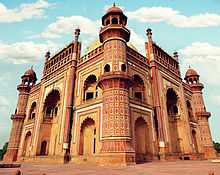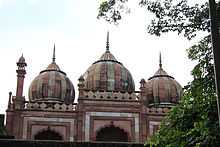Tomb of Safdarjung
| Tomb of Safdarjung | |
|---|---|
 Tomb of Safdarjung | |
 Location within Delhi
| |
| General information | |
| Type | Tomb |
| Architectural style | Mughal |
| Location | New Delhi, India |
| Coordinates | 28°35′21″N 77°12′38″E / 28.589266°N 77.210506°ECoordinates: 28°35′21″N 77°12′38″E / 28.589266°N 77.210506°E |
| Completed | 1754 |
Safdarjung's Tomb is a sandstone and marble mausoleum in New Delhi, India. It was built in 1754 in the late Mughal Empire style for the statesman Safdarjung, and was described as "the last flicker in the lamp of Mughal architecture".[1] The monument has an ambiance of spaciousness and an imposing presence with its domed and arched red brown and white coloured structures.[2] Safdarjung was made prime minister of the Mughal Empire (Wazir ul-Mamlak-i-Hindustan) when Ahmad Shah Bahadur ascended the throne in 1748.
Geography
The tomb is located near the Safdarjung Airport at the "T" junction of Lodhi Road and Aurobindo Marg (road) in New Delhi.[3]
Background

Mirza Muqim Abul Mansur Khan, who was popularly known as Safadarjung, who ruled over Avadh was an independent ruler of Avadh as viceroy of Muhammad Shah.[4] He was very rich and most powerful. With the death of Emperor Muhammad Shah of Mughal Empire, he moved to Delhi.[5] When Mohammed Shah Ahmed Shah ascended the throne of the Mughal Empire in Delhi in 1748, Safdarjung was made the Chief Minister (Vizier) of the empire with the title of Wazir ul-Mamalk-i-Hindustan and at that time the empire was on decline as their rule extended only to North India.[6]
As Vizier he had taken all powers under his control as the king was only a puppet, a figure head, who was unto enjoying life with wine, opium and women. But he overestimated and over exercised his powers with the result that the Emperor’s family called their Hindu Maratha confederacy to help them get rid of their Vizier. A civil strife ensued and eventually in 1753 Safdarjung was driven out of Delhi.[5][6] He died soon thereafter in 1754. After his death his son Nawab Shujaud Daula pleaded with the Mughal Emperor to permit him to erect a tomb for his father in Delhi. He then built the tomb, which was designed by an Abyssininan architect.[6]
To the south of this tomb is the historic site of the battle that was fought in 1386 between Timur of Mangol and Mohammed Tughlaq when the latter was defeated.[4]
Architecture



The Safdarjung tomb, the last monumental tomb garden of the Mughals, was planned and built like an enclosed garden tomb in line with the style of the Humayun Tomb. It was completed in 1754.[7] [8]
The tomb has four key features which are: The Charbagh garden plan with the mausoleum at the center, a ninefold floor plan, five part façade and a large podium with a hidden stairway.[9]
The main entry gate to the tomb is two storied and its façade has very elaborate ornamentation over plastered surfaces and is in ornate purple colour. There is an inscription in Arabic on the surface and its translation reads “When the hero of plain bravery departs from the transitory, may he become a resident of god’s paradise”. The rear side of the façade, which is seen after entering through the gate, has many rooms and the library. To the right of the gate is the mosque which is a three domed structure marked with stripes.[3][5]
Entering through the main gate gives a perfect view of the mausoleum.[3] Its walls are built high and the central dome, which is the main mausoleum of Safdarjung, is built over a terrace. Red and buff stones are the materials used for building the main mausoleum which measures 28 metres (92 ft) square. The central chamber, square in shape, has eight partitions with a cenotaph in the middle. Here there are partitions in rectangular shape and the corner partitions are in octagonal shape. The interior of the tomb is covered with rococo plaster with decorations. There are four towers around the main tomb at the corners which are polygonal in shape and are provided with kiosks. They have marble panels which are faded, and decorated arches. There is an underground chamber in the mausoleum which houses the graves of Safadrjung and his wife. The ceiling of the mosque has been plastered, painted and ornamented.[4][5]
The façade though built in the style of the Taj Mahal lacks symmetry as the vertical axis has been given prominence which has resulted in an unbalanced appearance to the tomb. The dome is more elongated, the central part has a taller Pishtaq. The four minarets at the four corners are part of the main mausoleum which was totally a different concept in elevation compared to the Tajmahal where the towers are detached and away from the facade of the tomb.[9]
The architecture of the tomb is praised and also derided, It is derided for the lack of proportioning of its various units and use of poor material for construction. Reginald Heber, who was Bishop of Calcutta between 1823 and 1826, based on the light brown colour of the stone used, had observed that the tomb has the “colour of potted meat”. Even ASI has observed that the marble used for ornamentation in the towers though pleasing is “rather florid”.[10] Another observation is that the tomb can not be compared to the Taj Mahal or the Humayun Tomb, as, at the time it was built, Mughal Empire was on the decline and sandstone had to used and lines were set improperly and the quality appeared “thread bare.”[5]
Garden

The garden surrounding the tomb has an area of 2,952 square feet (274.2 m2) and has a lay out in the form of four squares with wide foot paths and water tanks, which have been further subdivided into smaller squares. The garden is in the Mughal charbagh garden style which is a smaller version of the Humayun Tomb which is also built in Delhi. One channel leads to the entrance gate and the other leads to the three pavilions. The main podium over which the mausoleum is built measures 50 metres (160 ft) on each side. The high walls have been built in rubble stone masonry and have recessed arches in the interior. The towers or chatris are octagonal in shape. Its overall layout consists of four pavilions which have multiple chambers and the entrance gateway to the east is impressive. On the eastern side adjoining the gate are many apartments and a mosque, and a courtyard. The pavilions are laid out in the western, northern and southern directions and are named Jangli Mahal (palace in the forest), Moti Mahal (pearl palace) and Badshah Pasand (King’s favorite) respectively. Nawab’s family used to reside in these pavilions. Now the entire monument is under the control of Archaeological Survey of India (ASI) who have their offices in the pavilions and also a library over the main gate[4][11]
Gallery
-
Main gate as seen from the monument
-
View of interior
-

Cenotaph of Safdarjung
-

View across garden towards marble mausoleum
See also
- Tomb of Asif Khan in Lahore
References
- ↑ Environment, Security and Tourism Development in South Asia: Tourism development in South Asia. Gyan Publishing House. 2004. pp. 20–. ISBN 978-81-8205-139-3. Retrieved 5 August 2013.
- ↑ Vassanji 2009, p. 94.
- ↑ 3.0 3.1 3.2 Batra 2012, p. 12.
- ↑ 4.0 4.1 4.2 4.3 Sharma 2011, pp. 245-250.
- ↑ 5.0 5.1 5.2 5.3 5.4 Dalrymple 2003, pp. 136-138.
- ↑ 6.0 6.1 6.2 Batra 2012, p. 11.
- ↑ The Ultimate BQC Book of Knowledge volume 2. Rupa Publications. p. 29. ISBN 978-81-291-2361-9. Retrieved 5 August 2013.
- ↑ Brown & Hutton 2011, p. 204.
- ↑ 9.0 9.1 Raezer & Raezer 2011, p. 44.
- ↑ Batra 2012, p. 13.
- ↑ Batra 2012, pp. 11-13.
Bibliography
- Sharma, Anu (25 June 2011). Famous Monuments of India. Pinnacle Technology. ISBN 978-1-61820-545-2.
- Batra, Ravi (1 January 2012). The Splendour of Lodi Road: My Brush with Heritage. TERI Press. ISBN 978-81-7993-446-3.
- Raezer, David; Raezer, Jennifer (5 August 2011). Mughal Architecture in India: Guide to Delhi and Agra,Approach Guides. Approach Guides. ISBN 978-1-936614-25-7.
- Vassanji, M.G. (18 March 2009). A Place Within: Rediscovering India. Doubleday Canada. ISBN 978-0-307-37177-5.
- Brown, Rebecca M.; Hutton, Deborah S. (27 April 2011). A Companion to Asian Art and Architecture. John Wiley & Sons. ISBN 978-1-4443-9632-4. Retrieved 5 August 2013.
- Dalrymple, William (25 March 2003). City of Djinns: A Year in Delhi. Penguin Group US. ISBN 978-1-101-12701-8.
External links
![]() Media related to Safdarjung's Tomb at Wikimedia Commons
Media related to Safdarjung's Tomb at Wikimedia Commons
| ||||||||||||||||||||

.JPG)